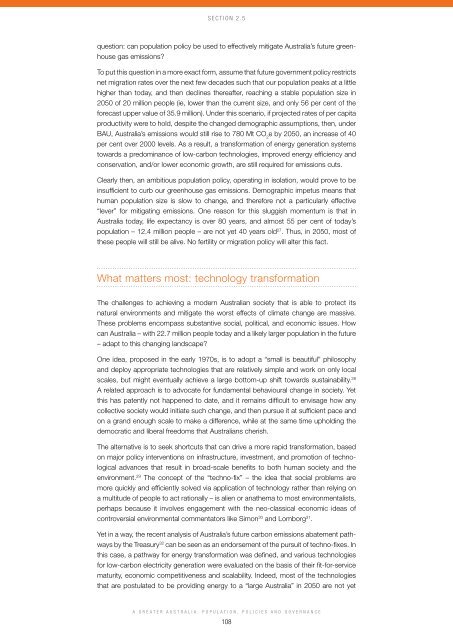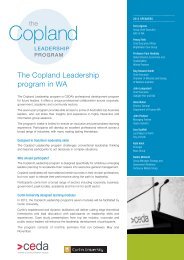Section 2.5else. Even with a broad international commitment about CO 2emissions, it is temptingfor a nation like <strong>Australia</strong> to “free ride” <strong>and</strong> keep burning coal for its electricity, unlessinternational sanctions <strong>and</strong> <strong>Australia</strong>ns’ moral sense of fair play, dictate otherwise.To decide not to do this, there must be a social <strong>and</strong> environmental justification, tiedto rigorous energy, economic <strong>and</strong> population policy. We can anticipate many of theimpacts of future global warming, <strong>and</strong> we have the ability to make the key economic<strong>and</strong> technological choices required to substantially mitigate emissions. But will we actin time, <strong>and</strong> will it be with sufficient effort, to avoid dangerous climate change?Focusing first on the short-term 2020 goal, the <strong>Australia</strong>n Government’s expectation isthat total national emissions will actually rise from the 2011 figure of 578 Mt of CO 2e to621 Mt by 2020 – a net growth of 7.5 per cent over the next nine years. 19 Yet the goalis five per cent below 2000 levels of 558 Mt, so the target number the government isseeking to reach is 530 Mt. The BAU expectation is 680 Mt, so the newly legislatedcarbon tax <strong>and</strong> other emissions reduction incentives (such as energy efficiency <strong>and</strong>renewable energy certificates) are expected to save about 60 Mt compared with theno policy approach. To fill the 91 Mt gap, Treasury modelling suggests that 15 per centof the 2020 emissions reductions will come from international carbon pollution permitsfrom developing countries, including clean energy projects, avoided deforestation, <strong>and</strong>so on. 20 These are of course difficult to verify, but that is the concept.The heavy reliance on foreign abatement credits to supplement domestic efforts willcontinue through to 2050. In July 2011 the Treasury released new modelling whichlooked at a range of energy scenarios (assuming a mix of energy efficiency <strong>and</strong> conservation,renewable energy <strong>and</strong> fossil fuels, but excluding nuclear) <strong>and</strong> design features ofa carbon pricing scheme. 21 The core policy scenario assumes global action to stabiliseCO 2e at 550 ppm by the year 2100, which aligns with <strong>Australia</strong>’s current emissionsreduction target of 80 per cent by 2050. The energy mix in 40 years is assumed tocontinue with a majority reliance on fossil fuels (black coal, oil <strong>and</strong> natural gas, abouthalf of which makes use of carbon capture <strong>and</strong> storage technology), but with between35 <strong>and</strong> 47 per cent coming from renewables, up from an 11 per cent share today. 22Alternatives: steady or declining <strong>Australia</strong>npopulation?St<strong>and</strong>ard policy analyses on emissions abatement involve the modelling of energy <strong>and</strong>economic growth pathways, <strong>and</strong> a conjecture about future population size. The defaultassumption is that population will continue to grow in the coming decades, with themid-range estimate, as described above, being an increase from 22.7 million people in2011 to 31.3 million in 2050. <strong>Australia</strong>’s total fertility rate is currently 1.78 23 , which is theaverage number of children born to a woman if she were to survive through to the endof her reproductive life. This is below the replacement fertility rate, which for <strong>Australia</strong>(with a low mortality rate) is a little less than 2.1 24 . Yet <strong>Australia</strong>’s population continuesto grow at a rate of 1.15 per cent per year, due to our substantial net migration rate,recently six migrants per 1000 population. That is, without migration, <strong>Australia</strong>’s populationwould now be contracting, not growing, as is already the case for many OECDnations with lower immigration rates, such as Germany, Italy, France, Sweden, Japan<strong>and</strong> Korea. 26Because <strong>Australia</strong>’s population growth is now determined by migration policy, ourfuture population trajectory is, in theory, “tuneable”, via adjustment of net migrationrates, without any need for recourse to other forms of population control such as incentivesfor fertility reductions. This situation allows us to pose an interesting hypotheticalA <strong>Greater</strong> <strong>Australia</strong>: <strong>Population</strong>, Policies <strong>and</strong> Governance107
Section 2.5question: can population policy be used to effectively mitigate <strong>Australia</strong>’s future greenhousegas emissions?To put this question in a more exact form, assume that future government policy restrictsnet migration rates over the next few decades such that our population peaks at a littlehigher than today, <strong>and</strong> then declines thereafter, reaching a stable population size in2050 of 20 million people (ie, lower than the current size, <strong>and</strong> only 56 per cent of theforecast upper value of 35.9 million). Under this scenario, if projected rates of per capitaproductivity were to hold, despite the changed demographic assumptions, then, underBAU, <strong>Australia</strong>’s emissions would still rise to 780 Mt CO 2e by 2050, an increase of 40per cent over 2000 levels. As a result, a transformation of energy generation systemstowards a predominance of low-carbon technologies, improved energy efficiency <strong>and</strong>conservation, <strong>and</strong>/or lower economic growth, are still required for emissions cuts.Clearly then, an ambitious population policy, operating in isolation, would prove to beinsufficient to curb our greenhouse gas emissions. Demographic impetus means thathuman population size is slow to change, <strong>and</strong> therefore not a particularly effective“lever” for mitigating emissions. One reason for this sluggish momentum is that in<strong>Australia</strong> today, life expectancy is over 80 years, <strong>and</strong> almost 55 per cent of today’spopulation – 12.4 million people – are not yet 40 years old 27 . Thus, in 2050, most ofthese people will still be alive. No fertility or migration policy will alter this fact.What matters most: technology transformationThe challenges to achieving a modern <strong>Australia</strong>n society that is able to protect itsnatural environments <strong>and</strong> mitigate the worst effects of climate change are massive.These problems encompass substantive social, political, <strong>and</strong> economic issues. Howcan <strong>Australia</strong> – with 22.7 million people today <strong>and</strong> a likely larger population in the future– adapt to this changing l<strong>and</strong>scape?One idea, proposed in the early 1970s, is to adopt a “small is beautiful” philosophy<strong>and</strong> deploy appropriate technologies that are relatively simple <strong>and</strong> work on only localscales, but might eventually achieve a large bottom-up shift towards sustainability. 28A related approach is to advocate for fundamental behavioural change in society. Yetthis has patently not happened to date, <strong>and</strong> it remains difficult to envisage how anycollective society would initiate such change, <strong>and</strong> then pursue it at sufficient pace <strong>and</strong>on a gr<strong>and</strong> enough scale to make a difference, while at the same time upholding thedemocratic <strong>and</strong> liberal freedoms that <strong>Australia</strong>ns cherish.The alternative is to seek shortcuts that can drive a more rapid transformation, basedon major policy interventions on infrastructure, investment, <strong>and</strong> promotion of technologicaladvances that result in broad-scale benefits to both human society <strong>and</strong> theenvironment. 29 The concept of the “techno-fix” – the idea that social problems aremore quickly <strong>and</strong> efficiently solved via application of technology rather than relying ona multitude of people to act rationally – is alien or anathema to most environmentalists,perhaps because it involves engagement with the neo-classical economic ideas ofcontroversial environmental commentators like Simon 30 <strong>and</strong> Lomborg 31 .Yet in a way, the recent analysis of <strong>Australia</strong>’s future carbon emissions abatement pathwaysby the Treasury 32 can be seen as an endorsement of the pursuit of techno-fixes. Inthis case, a pathway for energy transformation was defined, <strong>and</strong> various technologiesfor low-carbon electricity generation were evaluated on the basis of their fit-for-servicematurity, economic competitiveness <strong>and</strong> scalability. Indeed, most of the technologiesthat are postulated to be providing energy to a “large <strong>Australia</strong>” in 2050 are not yetA <strong>Greater</strong> <strong>Australia</strong>: <strong>Population</strong>, Policies <strong>and</strong> Governance108
- Page 2 and 3:
A Greater Australia:Population, pol
- Page 4 and 5:
ContentsForeword CEDA Chief Executi
- Page 6 and 7:
ForewordIt is with pleasure that I
- Page 8 and 9:
IntroductionResponding to the resul
- Page 10 and 11:
IntroductionA more dynamic and vita
- Page 12 and 13:
IntroductionSustainabilityConcern a
- Page 14 and 15:
IntroductionThe new demographics, h
- Page 16 and 17:
Section 1.0Historical perspectives1
- Page 18 and 19:
Section 1.1IntroductionJapan’s cr
- Page 20 and 21:
Section 1.1Figure 1Forecast number
- Page 22 and 23:
Section 1.1Table 1Defence spending
- Page 24 and 25:
Section 1.1How much defence is enou
- Page 26 and 27:
Section 1.1ConclusionA substantial
- Page 28 and 29:
Section 1.2There has been over a ce
- Page 30 and 31:
Section 1.2Resource constraints wer
- Page 32 and 33:
Section 1.2Similarly, in the 1994 H
- Page 34 and 35:
Section 1.2ReferencesAustralia, Dep
- Page 36 and 37:
Section 1.3IntroductionAustralia is
- Page 38 and 39:
Section 1.3The grey 90sThe heady ex
- Page 40 and 41:
Section 1.3Taylor’s stony rebutta
- Page 42 and 43:
Section 1.3Figure 1The Benhamite Op
- Page 44 and 45:
Section 1.3In mathematical terms, t
- Page 46 and 47:
Section 1.3characterisation of the
- Page 48 and 49:
Section 1.3ConclusionA retrospectiv
- Page 50 and 51:
Section 2.0Population futures2.1 Fo
- Page 52 and 53:
Section 2.1Conventional population
- Page 54 and 55:
Section 2.1It is more useful for go
- Page 56 and 57:
Section 2.1Forecasting of births, w
- Page 58 and 59: Section 2.1Future net overseas migr
- Page 60 and 61: Section 2.13). This had a lot to do
- Page 62 and 63: Section 2.2IntroductionIn late Sept
- Page 64 and 65: Section 2.2Figure 1The migrant cont
- Page 66 and 67: Section 2.2The visa and residency s
- Page 68 and 69: Section 2.2sponsorship, subject to
- Page 70 and 71: Section 2.2Figure 3Historical and p
- Page 72 and 73: Section 2.2The views in this chapte
- Page 74 and 75: Section 2.3IntroductionThe Australi
- Page 76 and 77: Section 2.3Figure 3Australia: Distr
- Page 78 and 79: Section 2.3Table 2Australia: Popula
- Page 80 and 81: Section 2.3Table 4Views of Australi
- Page 82 and 83: Section 2.3Table 5Australian States
- Page 84 and 85: Section 2.3A number of hypotheses h
- Page 86 and 87: Section 2.3Table 8Australia: Distri
- Page 88 and 89: Section 2.3Table 10Non-Metropolitan
- Page 90 and 91: Section 2.3Policy issuesThe configu
- Page 92 and 93: Section 2.3Climate change is likely
- Page 94 and 95: Section 2.3ConclusionAny realistic
- Page 96 and 97: Section 2.340 Swan, W., 2010.Austra
- Page 98 and 99: Section 2.4IntroductionThe Australi
- Page 100 and 101: Section 2.4At present there is a hi
- Page 102 and 103: Section 2.4innovation initiatives w
- Page 104 and 105: Section 2.4Endnotes1 Henry, K 2009,
- Page 106 and 107: Section 2.5IntroductionAustralia is
- Page 110 and 111: Section 2.5commercially viable - th
- Page 112 and 113: Section 2.5A vast country like Aust
- Page 114 and 115: Section 3.0Society and the individu
- Page 116 and 117: Section 3.1Extent of public opinion
- Page 119 and 120: Section 3.1category immigrant/forei
- Page 121 and 122: Section 3.1The Environics Research
- Page 123 and 124: Section 3.1Per cent100908070Figure
- Page 125 and 126: Section 3.1A number of surveys soug
- Page 127 and 128: Section 3.1Table 8Percentage who an
- Page 129 and 130: Section 3.1A more precise indicatio
- Page 131 and 132: Section 3.1The strongest predictor
- Page 133 and 134: Section 3.1Endnotes1. There is also
- Page 135 and 136: 3.2Social inclusion and multicultur
- Page 137 and 138: Section 3.2a broader definition of
- Page 139 and 140: Section 3.2Figure 1Estimated povert
- Page 141 and 142: Section 3.2Table 2Visa Type of Sett
- Page 143 and 144: Section 3.2Table 5First Generation
- Page 145 and 146: Section 3.2Table 6Australia: First
- Page 147 and 148: Section 3.2Improving outcomes for v
- Page 149 and 150: Section 3.2increasing diversity of
- Page 151 and 152: 3.3Linkages between education and p
- Page 153 and 154: Section 3.3Education and productivi
- Page 155 and 156: Section 3.3In the past decade, prod
- Page 157 and 158: Section 3.3succeed in education or
- Page 159 and 160:
Section 3.3case, funding also could
- Page 161 and 162:
Section 3.3Endnotes1 IGR 2010: Chal
- Page 163 and 164:
3.4Healthcare delivery for our agei
- Page 165 and 166:
Section 3.4• Private medical serv
- Page 167 and 168:
Section 3.4the whole spectrum of in
- Page 169 and 170:
Section 3.45. Experiences, pathways
- Page 171 and 172:
Section 3.4Stratification of patien
- Page 173 and 174:
Section 3.4Other steps include impr
- Page 175 and 176:
Section 3.438 National Health Refor
- Page 177 and 178:
4.1The economic effects ofpopulatio
- Page 179 and 180:
Section 4.1population growth can ex
- Page 181 and 182:
Section 4.1In theory, the answer pa
- Page 183 and 184:
Section 4.1Kirchner concedes that t
- Page 185 and 186:
Section 4.1Endnotes1. Productivity
- Page 187 and 188:
4.2Urban infrastructure and land us
- Page 189 and 190:
Section 4.2bearing the fixed costs
- Page 191 and 192:
Section 4.2Figure 1Indicative dwell
- Page 193 and 194:
Section 4.2Taking the electricity,
- Page 195 and 196:
Section 4.2Promoting better land us
- Page 197 and 198:
Section 4.2preferences to homeowner
- Page 199 and 200:
Section 4.2in any Australian urban
- Page 201 and 202:
Section 4.2Endnotes1 Productivity C
- Page 203 and 204:
4.3Water security:Water for the far
- Page 205 and 206:
Section 4.3Water trading enables us
- Page 207 and 208:
Section 4.3cent of water entitlemen
- Page 209 and 210:
Section 4.3were either the full eco
- Page 211 and 212:
Section 4.3Strategic opportunitiesA
- Page 213 and 214:
4.4Critiquing governmentregional de
- Page 215 and 216:
Section 4.4However, there is often
- Page 217 and 218:
Section 4.4Potential policy interve
- Page 219 and 220:
Section 4.4Unfortunately, advocacy
- Page 221 and 222:
Section 4.4contribute substantially
- Page 223 and 224:
Section 4.418 Department of Educati
- Page 225 and 226:
5.1The future of population policyG
- Page 227 and 228:
Section 5.1a million fewer women in
- Page 229 and 230:
Section 5.1For the present, ongoing
- Page 231 and 232:
Section 5.1The second worry is that
- Page 233 and 234:
Section 5.1The now significantly de





